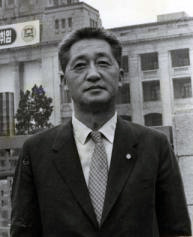Pak Mok-wol facts for kids
Quick facts for kids
Pak Mog-wol
|
|
|---|---|
 |
|
| Born | January 6, 1916 Gyeongju, Korea |
| Died | March 24, 1978 (aged 62) Yongsan District, Seoul, South Korea |
| Occupation | Poet |
| Language | Korean |
| Korean name | |
| Hangul |
박목월
|
| Hanja | |
| Revised Romanization | Bak Mok-wol |
| McCune–Reischauer | Pak Mogwŏl |
| Birth name | |
| Hangul |
박영종
|
| Hanja | |
| Revised Romanization | Bak Yeongjong |
| McCune–Reischauer | Pak Yŏngjong |
Pak Mog-wol (Korean: 박목월, 6 January 1916 – 24 March 1978) was a very important Korean poet and a university professor. He is known for his beautiful poems that often described nature and the feelings of everyday life. His work helped shape modern Korean poetry.
Contents
Early Life and Education
Pak Mog-wol was born on January 6, 1916. His birth name was Pak Yeongjong. He was born in a village called Moryang in Gyeongju, which is in South Korea today. His parents were Pak Jun-pil and Pak In-jae. He also had a younger brother and two younger sisters.
He finished Keisung Middle School in Daegu in 1935. This school is now called Keisung High School. After school, he lived in Tokyo, Japan, for about two years. During this time, he spent a lot of time writing poems.
Writing and Teaching Career
From 1939 to 1940, some of Pak Mog-wol's poems were published in a magazine called Munjang. However, during this time, Korea was under Japanese rule. The Japanese government started to control what could be published. Because of this, Pak Mog-wol stopped publishing his poems for a while. He kept writing them privately until Korea became free.
Pak Mog-wol married Yu Ik-sun. They had four sons and one daughter together.
After 1946, Pak Mog-wol started teaching at different schools. These included Keisung Middle School and Ewha Girls' High School. In 1953, he became a professor at Hongik University. Later, in 1961, he moved to Hanyang University as a professor. There is even a statue of him at Hanyang University! He eventually became the head of the university's College of Humanities.
In 1966, he was chosen to be a member of the National Academy of Arts of the Republic of Korea. He was also a leader in the Society of Korean Poets. He died on March 24, 1978, at his home in Seoul.
His Poetic Work
Pak Mog-wol started his writing career as part of a group called Cheongrok-pa. This means "Blue Deer school." There were three poets in this group, including Cho Chi-hun and Pak Tu-jin. They were all named after a poetry book they appeared in together in 1946.
Even though they had different styles, their poems often focused on nature and human hopes. Pak Mog-wol's early poems created a new style in Korean poetry. He tried to show a childlike sense of wonder and innocence. He used folk songs and local language in his poems.
One of his famous poems from this time is "The Wayfarer" (나그네). A musician named Isang Yun even set it to music.
|
강나루 건너서 |
Across the ferry |
After the Korean War, Pak Mog-wol's poetry style changed. He started to include the pain, death, and even the everyday struggles of life in his poems. He didn't always try to make them sound beautiful or emotional. His poetry collections, Wild Peach Blossoms (Sandohwa) and Orchids and Other Poems (Nan. Gita), show this new goal. He wanted to show how people react to both the good and bad parts of life.
However, his later poems went back to using lively, everyday language. He used this language to show the color and energy of local Korean culture. His collection Fallen Leaves in Gyeongsang-do (Gyeongsang-doui garangnip) explores big ideas. These ideas include the relationship between light and dark, happiness and sadness, and life and death.
Pak's poetry, especially his later work, shows a strong love for life. This love doesn't disappear, even though he knew that life would eventually end. People admire his work for its careful hopefulness. He was also good at showing real-life problems in his poems, even though they seemed to be about local places and everyday language.
Awards and Legacy

Pak Mog-wol received many awards for his work. These include the Freedom Literature Awards, the May Literature and Art Awards, and the Seoul City Culture Awards in 1969. In 1972, he received the Moran Medal of the Order of Civil Merit. In 2007, the Korean Poets' Association named him one of the ten most important modern Korean poets.
Pak Mog-wol lived in a house in Seoul from 1965 until he died in 1978. The Seoul government wanted to save his house as a cultural heritage site. This means it would be protected because of its historical importance. However, his son had to sell the house in 2002 to pay off debts. The new owner tore down the house in 2004. This event, along with similar situations for other famous people's homes, made people more interested in protecting cultural heritage in South Korea.
See also
- Korean literature
- List of Korean-language poets

